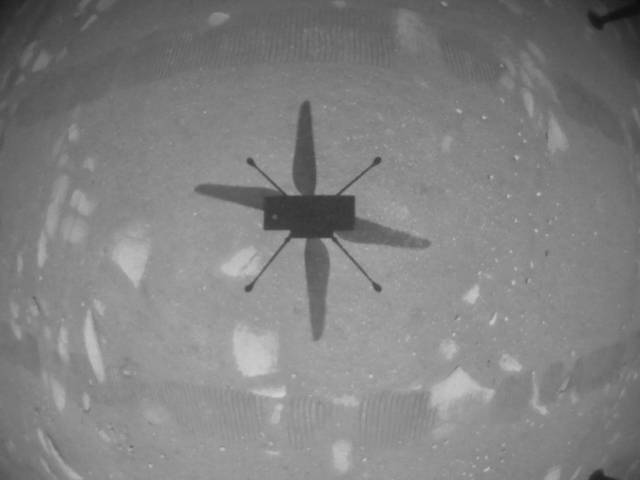Yesterday a four-pound machine sitting on Mars, powered by sunshine only half as strong as the noon sun we get on Earth, spun its two four-foot-long carbon-fiber rotors at 2,400 revolutions per minute, rose ten feet in the mortally thin Martian air, hovered for 39 seconds, turned 96 degrees, and landed without breaking. And because Mars is 180 million miles away, which radio signals need 16 minutes to cover, that machine couldn’t operate under direct human control; it had to operate on math and logic coded onto a 2014-vintage smartphone processor.
The flight of the Ingenuity helicopter actually improved its performance:
Bob Balaram, Ingenuity’s chief engineer, told reporters the helicopter was in fine fettle following the maiden run.
“She’s even healthier than she was before this flight — she shook off some of her dust that had been covering the solar panels, and is in fact producing even more solar energy than before” [“NASA’s Mars Helicopter Succeeds in Historic First Flight,” AFP via Shanghai Daily, 2021.04.20].
Ingenuity’s flight yesterday and its planned longer flights will provide data to inform a plan NASA and the European Space Agency have to send another robot to Mars in a few years to pick up samples collected by the helicopter’s parent rover Perseverance and bring them back to Earth:
The plan is for Perseverance to stash samples of rock and soil in an area around Jezero Crater, where the rover landed in February. Those samples will then be collected, all things going to plan, by a subsequent mission at the end of this decade.
NASA and ESA have been studying options for what they are calling a Sample Retrieval Lander. That lander will include another rover, which will collect the samples, a mobile launchpad and a rocket-like capsule to bring the stuff back.
Using what scientists hope to learn about launching from Mars and test flying Ingenuity, the capsule — or “ascent vehicle” — will leave the planet in around 2028 and rendezvous with an orbiting spacecraft. That spacecraft will then grab the samples and take them on their onward journey home [“How the Mars Helicopter Will Bring Humans Back to Earth,” Deutsche Welle, 2021.04.15].

The science and engineering required to get Ingenuity to Mars, deploy it from the belly of Perseverance, and make it fly in air far thinner than the air at the highest altitude reached by a helicopter in Earth’s atmosphere is pure, non-partisan, and true. The successful test of that science and engineering yesterday demonstrates what we can achieve when we stop bickering, agree on basic facts, and work together to solve really complicated problems.
Agreement to collaborate on the accomplishment of a specific task or goal is required. Agreement on what that goal is must precede.
… and it carried a postage-sized piece of fabric from the original Wright Flyer.
Science Rules
Beautiful technology.
grudznick is #4Science, as you all know. But do you think there is a small chance this was faked by the deep staters in NASA to keep their funding going? I say they need to fly this little drone a lot further and faster and then we can all get excited. Assuming it’s really “flying on Mars.”
grudznick
Let’s review.
Deep Staters were libbies in Washington that pretended to be loyal to Trump but were really working behind the scene to promote our liberal agenda.
Trump is gone and the Deep Staters are now “out of the basement” and able to work in the public eye, again.
PS … thanks for working with me to get “legal weed” in South Dakota. By pretending to be against it and working “deep” undercover, your help was pivotal to the new freedoms in SD. BRAVO!
Jezz grudz, pretty low boy. We’ve invaded Mars, get used to it.
Mr. Lansing, I suppose to you it’s just another of your goats gotten by grudznick to find out I’m a Deep Stater, but with a soewhat sick sense of wardrobe selection.